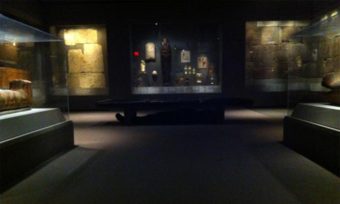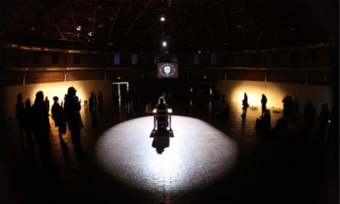Bathaus, DEAD ART STAR and Abuse of the Document
No address is given for the Bathaus. When things happen here, they are promoted slightly: there are announcements on Facebook, on blogs like v-e-l-l-u-m or fluxboston, and maybe in the Counter-Cultural Compass, but there is an in-crowd feeling, cheeky fill-ins of the informational fields. For Communion V, "a transdisciplinary ritual executed in sound, visuals & performance" that happened early in August, the only informational stub on location that appears on Facebook looks like this:
The announcement of the event on Flux Boston just said: Bathaus, and listed a contact person (she is sort of the Gertrude Stein of the Boston underground scene, Maggie Cavallo) who you could email about the address, if you need the address. . .
Underground practice harasses geography. A counter-culture, if it is healthy, refigures the landmarks and locations of its city. For a certain group, it manages to pull the heightened focus of the civic sphere onto a different, often private, space. That secrecy is one of the tools involved in this operation is not surprising.
It should not be surprising, either, that the work produced by artists who polarize these communities is shaped, if not defined, by the spaces they occupy. For artists on artists' budgets, Boston does not supply the loft, nor the enormous installation pieces that loft-spaces allow you to produce. It can, however, furnish the triple-decker townhouse. This can be given a name, treated like a kingdom, inhabited by complex micro-societies, and used on long nights for its public utility: the basement.
This way of using documentation isn't some trick for the internet generation (whatever that might mean). Its strategies are not a generation's, they are art's: a use of tools at hand to contain and describe experience.
The Bathaus is adjacent to an abandoned church with boarded windows, and the series of events titled Communion seems to sprout from a kind of biodegradation that richens the soil. Does space really work this way, by spiritual compost? Whether or not it does, the illusion is convincing here. Eerie proximity to a decaying church, with the strange spectacle of Nabeela Vega giving communion on a piece of canvas draped across the front steps, the omnipresence of earth as felt in New England basements which are actually under ground: something here plays geography like a harp. Here performance has no filtering agent, nothing even resembles a fourth wall. For the artists who perform at Bathaus (often simultaneous with DJs and bands, through multi-colored LED lights, while people swill canned beer), local are part of the art world, which is only by metaphor a cult, but community is as vital to their method as it is to religion. This produces a feeling of amateurism, but in the best sense: from the etymological root of the word, which I encourage everybody to look up in a dictionary. There is a very full humanity in this work, and an electric sensation of grittiness and risk.
"How can we begin to think of ourselves, rather than stagers of plays, as orchestrators of social interactions in which a performance is a part, but only a fragment of that interaction? How can we develop communities of individuals who are participants of an ongoing dialogue?" These are Anne Bogart's questions to theater artists, in an essay that will form the first chapter of her new book on neuroscience, storytelling, and theatrical methodology. If these are really the right questions to ask, much is being done at the Bathaus that provides a strategic reply. Whether I can express it in writing is another question, for (as I'm hoping to argue) much of what happens in a vibrant interactive community happens through a shared will to create its documents. To approach and record the core of what happens requires delicacy and technique: without these, very much slips away.
DEAD ART STAR is a twenty-something artist who came of age in Boston one way or another, and who was a painter without an all-caps moniker—but already with tortured questions about identity—when I first met him in 2009. His practice now draws on the function of celebrity, collapsing the space between life as a person and work as an artist. DEAD ART STAR has a Facebook page, separate from the person who enacts his existence. When he attends events where he is not technically performing, he often attends as DEAD ART STAR, and turns his attendance into a kind of social performance, underlined by outrageous costume that might involve face paint and long-haired wigs. This sometimes has the feeling of a kid going out after playing dress-up, but if the childlike tone is properly construed, it is part of his subtlety. Playful character acts put a winking accent onto the performativity of the social sphere, the performance of identity itself. And the artist, while performing, is also a photographer, whose documentation of Boston's community of performance artists forms both a record and an expression of its detail.
The documents DEAD ART STAR produces trace the outline of the auratic, unrecordable event that is performance. But to perform documentation produces an object with a different tone, with awareness of its own strange relationship to live art. DEAD ART STAR is an eerily complete and closed loop of identity, accentuating the tendency of social media to turn people into objects: he treats himself like a dead person, or else like a celebrity. Celebrity, photography, death: each of these is a crystallization of the event of human life, artifice turning life into a static object. DEAD ART STAR keeps all of these concepts in an easy orbit that is rarely expressed but—like a monument, like the strange name in capital letters that looks like tombstones poking out of the blocks of text I type—is weirdly magnetic and always available for the intuition of the observer's eye.
But at Communion V, DEAD ART STAR was not taking photographs. Instead he used materials that are classical in his repertoire as a performer: an elegant white gown with an Edwardian look, mirrors, and red fruit. He had created an environment for himself in one corner of the basement with dozens of mirrors of various shapes hanging or propped from floor to ceiling, a piece of red carpet, and two big jars of maraschino cherries. He held a white rose between his teeth, eyes closed, while slowly, carefully, the gown was tied to the front of his body with medical gauze. There is a strange dissociation as we see the front of the artist turn female, while the reflection of his back is a shirtless man's. When the dress has been tied on (Maggie Cavallo—Magzilla—did the honors) he begins to whip the skirts through the air in front of him. Slowly, surely, the dress falls from his body. He then begins to fill it, cherry by cherry, with the contents of the jars. Everybody is taking pictures with their phones. When the jars are empty he crushes the gown full of fruit to his body. He squeezes it for minutes. The air is noisy and the lights are very dim; he is crouching over the dress and keeps squeezing. At last he unrolls the bundle, reveals the dress, pink, and hangs it on a wire hanger from the ceiling.
Throughout all of this, there is a band—loud, with language and electrics, not remotely ambient—playing a set less than three feet away. People come and go. They look at him for a moment, take a picture, post it to Facebook or Instagram with a hashtag, and go to look at the band or find another beer. To some kinds of performer, the atmosphere would be unsupportable: this crowd has no focus, they drift around, they talk to each other, etc. They are out to have a good time. But what has been thoroughly digested and recognized, here, is that a good time for kids with media devices always involves a document from your experience. It isn't forced or asked for; it's a natural reaction to a strange visual scene, the kind that durational performance will often produce. The other side of an attention deficit is typically compulsive documentation. And DEAD ART STAR probably knows that people will want to take his picture: his tempo is by turns pleasantly manic (as he whips the dress) and glacially slow; he performs a strange semi-occult ritual that suggests both funerary arts and sex; and he uses gorgeous, eminently photographable materials. His practice is an isolation that lets people in, but to a fetishized space where the performer welcomes the vampiric photograph with the perversity of one of Bram Stoker's dead heroines. And so, this performance using only extremely analog materials (garment, mirror, fruit) continues in a wide, online sphere: it is a passive orchestration of audience interaction, going all the way to the bottom of the hashtag.
Of course, this is not the only way that these tools can be used: it should probably be more obvious than it is that the way work demands documentation is an aesthetic choice. In the case of DEAD ART STAR, identity is either transcribed on others through the practice of photography (and all its metaphors), or objectified by an audience that is allowed the pleasure of a possessive photograph (and all its metaphors). Both strategies, and the emotional qualities that play on or through the artist when they come to use, operate in a coherent scheme of intentions. They become opposite sides of the same strange document that is the performing and observing self.

This way of using documentation isn't some trick for the internet generation (whatever that might mean). Its strategies are not a generation's, they are art's: a use of tools at hand to contain and describe experience. What is recorded, what appears to be unchanging, bears a certain relation to what passes immediately away, and of course this is a state of affairs that has its reflection in life. Conscious documentation of performance can become work in itself: not a utility to be outsourced, but an opportunity to recognize something about the practice of making records, engaging the texture of the unchanging thing against the texture of the ephemeral event.
Some theater artists have now managed to open their horizons of space, with site-based work escaping the proscenium. The question of documentation involves opening the horizon of time.







Comments
The article is just the start of the conversation—we want to know what you think about this subject, too! HowlRound is a space for knowledge-sharing, and we welcome spirited, thoughtful, and on-topic dialogue. Find our full comments policy here